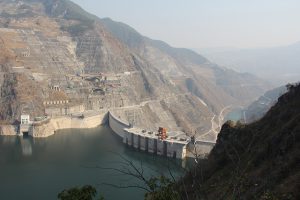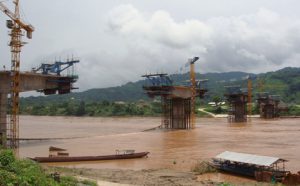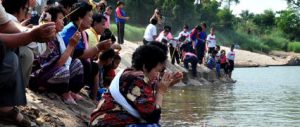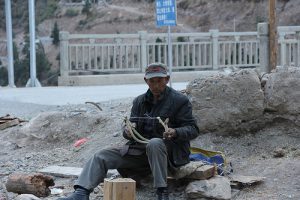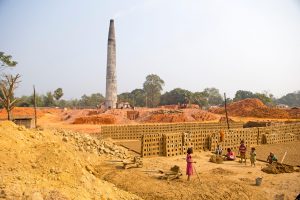After last week’s focus on China’s dam-building plans on the upper Mekong river, we now switch downstream to where Laos is pushing ahead with its own controversial projects
Just before the Mekong River enters Cambodia from Laos, it splits into many different branches and plunges over the 20 metre great fault line. The resulting maze of braided channels forms the magnificent wetland of Siphandone, or “four thousand islands”. Some of the channels are large and steep, forming spectacular waterfalls – notably the popular tourist attraction of the falls at Khone Phapheng. Many smaller channels in-between are equally steep and contained in narrow gorges.
The exception is the Hou Sahong channel: water passing through is much more gradual in its descent, making its way across the fault line in a series of rapids rather than falls. This makes Hou Sahong the most passable for fish. It represents the only passage through which significant numbers of fish migrate during the dry season; even at other times of year it is the channel through which most of the millions of fish undertaking their complex seasonal migrations pass.
On 30 September 2013, the Lao government notified the Mekong River Commission of its intention to plug Hou Sahong with a hydroelectric dam, known as Don Sahong after the island on the eastern bank of the waterway. The dam is to be built by a Malaysian property company, Mega First Corporation Berhad. The company also has two small investments in thermal power in Sabah in Borneo and China, but no experience in building dams or working in Laos.
The Don Sahong dam is designed to generate 260 megawatts of power, which puts it at the smaller end of the scale of the many dams currently being planned in Laos. It is by far the smallest on the Mekong mainstream.
But fisheries experts, environmental groups and communities up and down the Mekong River are alarmed at what the blockage might mean for the hundreds of species of fish that undertake their long-distance seasonal migrations across the falls to complete their spawning and feeding cycles.
The Siphandone area itself is the world’s largest artisanal freshwater fishery, so any major impact has severe implications for livelihoods and food security both in the falls area itself and for communities along the Mekong in Cambodia, Laos and Thailand.
Disrupting fish migration
Even the developers accept that no fish will be able to pass upstream through the Don Sahong dam. However, they propose an alternative solution. Work is already underway to clear and level two adjacent channels – Hou Sadam and Hou Xang Pheuak – to make their gradients more amenable to fish passage. The developers promise to study fish movement during construction to ensure that fish can follow these “improved” migration routes. They also promise to install “fish-friendly turbines” to reduce the mortality of fish that get churned through the powerhouse on their way back downstream.
Scientists and environmentalists are sceptical. Never has a natural migratory fishway on this scale been replaced by parallel routes. There are no studies that show the survival rate of fish passing through modified turbines. According to the guidelines laid down by the Mekong River Commission, the intergovernmental body that deals with issues surrounding the river, at least 95% of the natural migration would need to be accommodated by the new semi-artificial fishways. The bulk of world scientific opinion is that this is highly unlikely to succeed.
A letter was sent to the Lao government in 2007, signed by 34 leading scientific experts, warning that in dollar terms alone the Don Sahong Dam would be likely to destroy more of value to humans than it creates. An earlier environmental impact assessment (EIA) report for Don Sahong dam also warned against building across such an important fish migration channel. But the developers chose not to use its inconvenient findings, instead coming up with an EIA that promises an even better fishery once the channels are improved and the fishers are provided with alternative livelihoods to take the pressure off heavily exploited channels such as Hou Sadam.
A further environmental concern is the impact of the dam on one of the last remaining pods of Mekong Irrawaddy dolphins. They reside in a pool immediately below the falls, less than two kilometres downstream of the dam site. Apart from the noise of construction and the changed water flows from the dam itself, their dependence on fish moving up- and downstream means that any impact on the fishery also spells danger for the survival of these freshwater mammals.
Don Sahong would be the second dam on the mainstream of the Lower Mekong to be put under construction by Laos after Xayaburi, where construction started in November 2012. (Six of the eight planned dams on the upper Mekong in China are completed or under construction). However, unlike the Xayaburi Dam, Don Sahong has not been offered by the Lao government for prior consultation among signatories to the 1995 Mekong Agreement. The rationale given is that Don Sahong should not be treated as a mainstream dam, because it does not block the entire main-stem of the river. This is despite earlier documents produced by the Mekong River Commission that have consistently and unequivocally referred to Don Sahong as a mainstream project.
Under the Mekong Agreement signed by Laos, Vietnam, Cambodia and Thailand, any mainstream project that uses water year-round requires prior consultation. Non-mainstream projects simply require notification, with no formal process for taking account of other countries’ concerns and with no requirement to give notice well in advance of project commencement. Construction of the Don Sahong project is set to commence in November.
Neighbours stay silent
What does this unilateral action by the Lao government mean for the Mekong as a transboundary river? Given that Don Sahong is so close to the border with Cambodia, many Cambodian NGOs have been vocal in their reaction. The Cambodian government has said little. In part this may be explained by the preoccupation of forming a new government after contested election results. In part it may also be explained by the fact that Cambodia is embarking on construction of another dam with potentially devastating impacts on fisheries – the Lower Sesan 2, which experts have calculated would singlehandedly destroy 9% of the entire Mekong fishery.
Vietnam has also been quiet on Don Sahong. This may be because the hydrological and sediment effects of Don Sahong are likely to be quite minimal. Vietnamese scientists and decision makers are particularly concerned about these two areas of impact from mainstream dams because of the dependence of Delta agriculture on water flows and transport of silt. Migratory fisheries register as less important, despite evidence of the interconnectivity of fisheries along the length of the river.
In an earlier article for chinadialogue, I argued that China’s dam boom on the upper Mekong was fuelling hydropower ambitions lower down the river. There is a similar situation in the current race to the bottom in standards of sustainable and rational management of the Mekong, whereby each country chooses to go ahead with projects in the wake of upstream countries’ unilateral actions. These actions then discourage or delegitimise objections that downstream countries have to prior or concurrent actions taken by upstream neighbours.
A strong river basin organisation would be expected to intervene or facilitate rational discussion and decision-making around projects with potentially significant transboundary impacts. In the case of Don Sahong, this would entail immediate determination that Don Sahong is indeed a mainstream project and should be subject to the rules of prior consultation. However, the Mekong River Commission is not a strong organisation. The leadership of its secretariat waits for governments to take a stance. In the case of the Xayaburi, consultation processes at least forced Vietnam and Cambodia on the spot to react. In the case of Don Sahong, allowing the project to get away with a simple notification means a green light by default.
